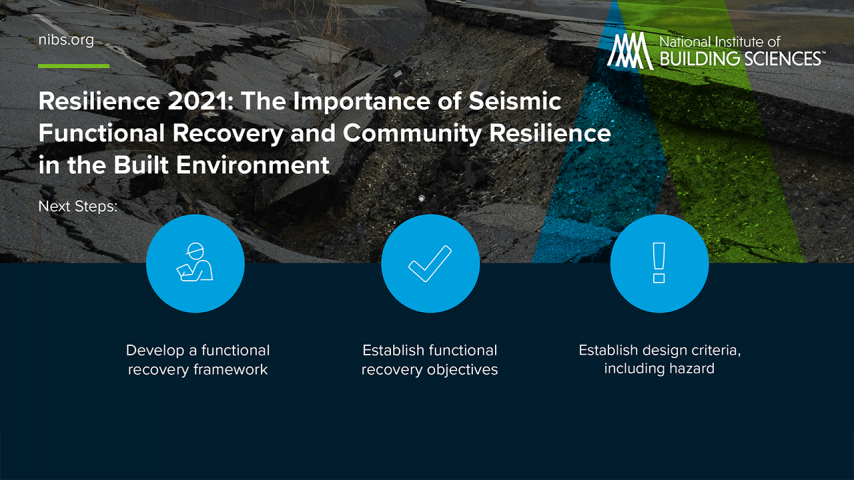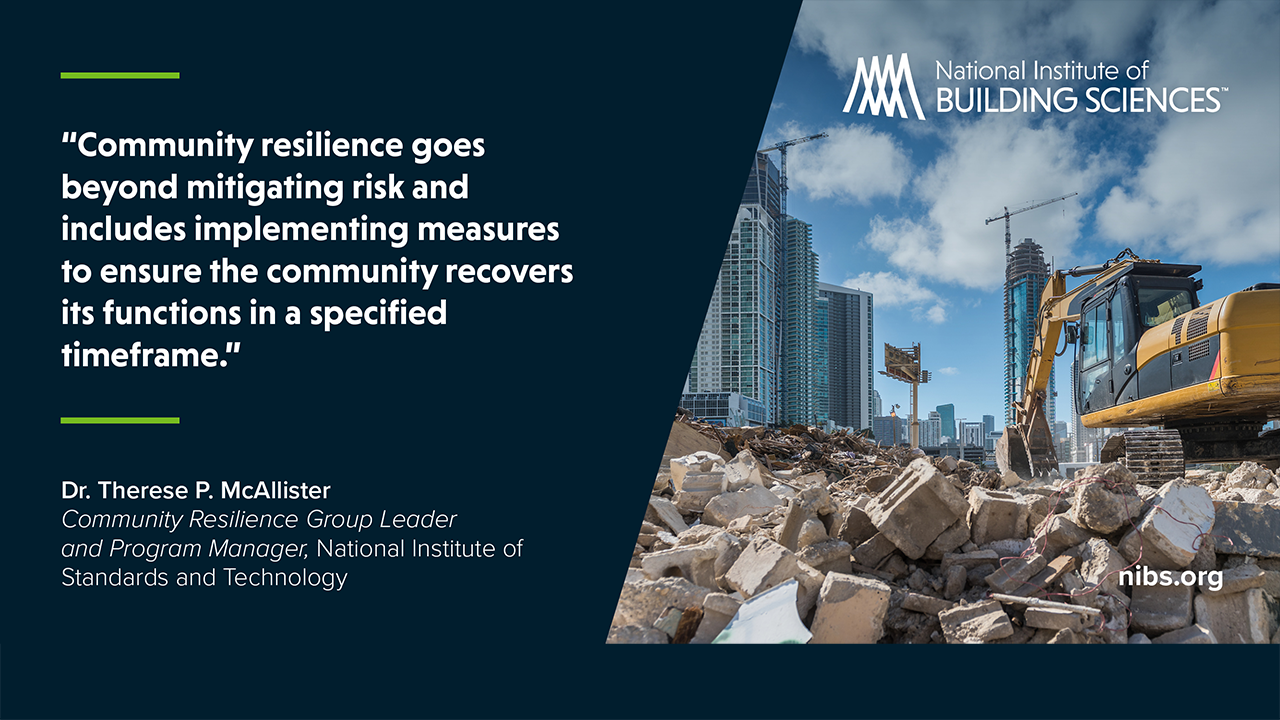
Nearly half of the U.S. population resides in portions of 42 states that are at risk of experiencing a damaging earthquake within the next 50 years. That’s according to the NIST-FEMA Special Publication (FEMA P-2090/NIST SP-1254), Recommended Options for Improving the Built Environment for Post-Earthquake Reoccupancy and Functional Recovery Time.
In regions of high seismic risk, where an earthquake hasn’t occurred for some time, scenario studies predict deaths in the thousands, injuries in the tens of thousands, and hundreds of billions of dollars in direct economic losses, along with long-term, destabilizing impacts to community function.
Our nation’s seismic risk is largely mitigated through earthquake-resistant buildings, which are regulated by model building codes. Federal policy now calls for improving functional recovery of the built environment to increase earthquake resilience at the community level. Functional recovery design represents a significant shift from the current safety-based practice for the building design and construction industry.
On September 8, 2021, the National Institute of Building Sciences hosted the next installment of the Resilience 2021 webinar series. Our expert panel included Dr. Therese P. McAllister, Community Resilience Group Leader and Program Manager, National Institute of Standards and Technology; John Hooper, SE, PE, Director, Earthquake Engineering, MKA; and Michael Mahoney, Senior Geophysicist, Federal Emergency Management Agency (FEMA). Charles J. Carter, SE, PE, PhD, President of the American Institute of Steel Construction and Chair of the Building Seismic Safety Council, served as moderator.
Our experts covered seismic functional recovery, community resilience, lifeline infrastructure systems, and the importance of “building beyond code.” We received nearly 500 registrants for this webinar.
NATIONAL EARTHQUAKE HAZARDS REDUCTION PROGRAM REAUTHORIZATION
According to Mahoney, FEMA and NIST submitted a functional recovery report to Congress in January.
The report regarded reauthorization of the National Earthquake Hazards Reduction Program (NEHRP); it was formally titled Recommended Options for Improving the Built Environment for Post-Earthquake Reoccupancy and Functional Recovery Time (FEMA P-2090/NIST SP-1254).
The final report introduced seven recommendations and performance levels and terminology. Each chapter covered one of the recommendations, with a total of 17 tasks and nine alternatives. The conclusion introduced four recommended actions by Congress.
SEVEN RECOMMENDATIONS IN THE FEMA-NIST REPORT
The seven recommendations in the report are as follows:
- Develop a framework for post-earthquake reoccupancy and functional recovery objectives.
- Design new buildings to meet recovery-based objectives.
- Retrofit existing buildings to meet recovery-based objectives.
- Design, upgrade, and maintain lifeline infrastructure systems to meet recovery-based objectives.
- Develop and implement pre-disaster recovery planning focused on recovery-based objectives.
- Provide education and outreach to enhance awareness and understanding of earthquake risk and recovery-based objectives.
- Facilitate access to financial resources needed to achieve recovery-based objectives.
Regarding the status of the report, Mahoney said the organizations have not yet heard back from Congress.
“FEMA and NIST are exploring ways of moving forward with this work using existing limited resources,” he said.
As it stands, functional recovery is a bridge to resilience.
The current situation involves new construction and changes to existing buildings, which are regulated by building codes. Building codes provide life safety except better for critical facilities and high-risk buildings, and lifelines follow industry standards. There is little coordination between the two, Mahoney said, and an entity like American Lifelines Alliance could potentially be utilized to facilitate the needed coordination.
COMMUNITY RESILIENCE GOES BEYOND MITIGATING RISK

NIST’s McAllister broke down the definition of resilience as the “ability to prepare for and adapt to changing conditions and to withstand and recover rapidly from disruptions.”
Community resilience goes further.
“Community resilience goes beyond mitigating risk and includes implementing measures to ensure the community recovers its functions in a specified timeframe,” she said.
McAllister broke down the NIST Community Resilience Program, which includes science-based tools to assess resilience and support informed decision-making, community engagement to perform outreach and help with collaboration, and disaster and failure studies, which provide metrology for field studies and data collection.
When it comes to planning for community resilience, it was found that most communities weren’t doing the first three steps, which include forming a collaborative planning team, understanding the situation, and determining the goals and objectives. McAllister said most engineers typically get involved in the understanding of the situation, determining goals and objectives, and planning development, which supports functional recovery work.
“When it comes to next steps for infrastructure design, a key component is enabling functional recovery,” McAllister said.
ONE BUILDING AT A TIME
The baseline of the building code is to provide safety, said Hooper, with MKA. Hooper also is a member of the Building Seismic Safety Council Provisions Update Committee.
He defined functional recovery as “a post-earthquake performance state in which a building … is maintained or restored to support the basic intended functions associated with the pre-earthquake use or occupancy.”
Hooper presented some ongoing research, looking at functional recovery time using the FEMA P-58 methodology and shared his vision on next steps, including developing a functional recovery framework, establishing functional recovery objectives, and establishing design criteria, including hazard.
Moderator Carter said infrastructure is just as important in the consideration of functional recovery.
“It doesn’t matter if we make the building functionally recoverable if everything around it doesn’t connect,” he said.
Existing buildings are also a great challenge. Said Carter: “A lot of buildings predate modern design knowledge and knowledge of how things can fail. We want to survey best practices and design and implementation guidelines.” While BSSC continues work with its partners on future NEHRP Provisions development for new buildings, functional recovery, lifelines and existing buildings are some strategic areas the BSSC Board of Directors and NIBS leadership are looking into.
McAllister added the need to develop baseline criteria that will apply to most communities. An important consideration is when a community may have, for example, a manufacturing plant that employs 50 percent of the community.
“We need to think baselines and how to provide guidance for beyond that,” she said, mentioning recent disasters including the Surfside condo collapse in Florida and the ongoing effects of Hurricane Ida on Louisiana.
WHAT’S COMING UP
The next Resilience 2021 webinar takes place October 19, 2021. It will cover building information management (BIM). To catch up on previous installments of the Resilience 2021 series, visit the site.




